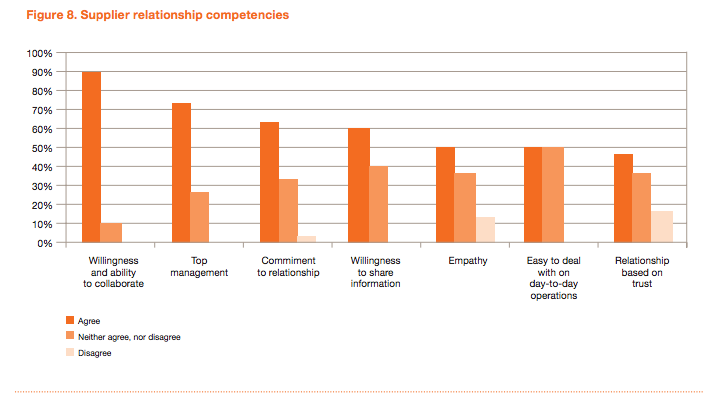We all know, or at least are vaguely familiar with the phrase, quality over quantity.
But, do we live by it?
Sure… sometimes, but our inherent human emotions of greed, gluttony, instant gratification, impulsivity and many other innate flaws don’t always lead us to the most rational decisions. Sometimes it’s easier to ‘super size’ our Big Mac combo than it is to make a trip to the grocery store, and cook a homemade meal.
%20(57).png?width=823&height=466&name=Blog%20Images%20etc%20(1917%20x%201085%20px)%20(57).png)
Quantity over quality can be a byproduct of circumstance, but your business decisions should not be your procurement strategy, and more specifically - supplier relationship management - shouldn’t be a byproduct of circumstance or impulsivity. Supplier relationships should be built methodically, assessed objectively and nurtured strategically.
Suppliers aren’t just your vendors, they are potential strategic partnerships, and they need to be managed accordingly.
There is great value in locating, and leveraging, your key supplier relationships. This article will offer some quick tips that the Kodiak Hub team has picked up over years of servicing global procurement teams with SRM software solutions to make sure that you’re on a path towards quality over quantity in your SRM. It’s important to keep in mind that having a lot of suppliers is easy, but having quality suppliers requires engagement and consolidation.
Sometimes… less really is more, but that — unfortunately — doesn’t always mean less work.
What Does the Supplier Relationship Mean to You?
A procurement organization won’t know what kind of supplier relationship they have, or what kind of management should be applied, until a supplier collaboration runs a full end-to-end cycle or two.
Sourcing strategically is the stepping stone for risk aversion, and ensuring the chances you’ll find yourself in quality collaborations, but there is no way of knowing how a supplier will perform until they’re presented with an opportunity to supply.
After you’ve collaborated with as supplier, it can be smart to evaluate the value of the relationship to your organization, and from here you’ll be able to develop a calculated approach for managing the relationship.
As deemed by Daniel R. Krause, in his 1998 study titled, An empirical investigation of supplier development: Reactive and strategic processes, there are two main approaches to the supplier management process:
- Reactive Approach — Where companies start managing the supplier relationships only when unpleasant situations with suppliers occur, and try to figure out how to improve the performance of unreliable suppliers.
- Strategic Approach — Where supplier relationship management starts even before an agreement with supplier is signs, in order to ensure the competitive advantage of the company in the long run. This is a forward-focused approach, which can lead to a successful relationship even in the early stages (purchasecontrol.com 2018).
The approach your organization will take towards supplier management will be individual to the needs and infrastructure of your organization. Taking the strategic approach is a path focused on partnership and long-term success, but you’ll sometimes have to be reactive within a procurement strategy, because the risks of the global supply chain are a bit more complex than a deduction to two pathways of supplier management.
The question you and your procurement organization need to ask yourselves: What purpose does this supplier relationship fill within our overall value chain?
Align Your Organizations
Strategic suppliers/Key suppliers can’t be seen as strategic partners unless if they share an understanding of your organization’s values and vision.
Communicating your vision, for collaboration, before a partnership commences is always a good choice. This allows the potentially strategic supplier to understand what they can expect from your organization, and vice versa.
It’s important to remember that the supplier is investing in the relationship just as much as your procurement organization. Just because they are the supplier/service provider doesn’t mean that you should treat them as a less powerful entity.

“Threats, aggression and negotiation stunts will likely undermine the degree of supplier trust into the relationship. Consider, rather, the supplier, as an extension of the internal organization and therefore subject to the professional respect afforded to co-workers” (Webb 2018).
In order to ensure that there is no misunderstanding within communication, and no lines are blurred, it can be smart to actively build the relationship upon the expectations/guidelines developed in your Supplier CoC.
Having a standardized document as a reference point can avoid any miscommunications or misunderstandings between you and your strategic suppliers. Furthermore, if things are working out well with a compliant-strategic supplier, and the relationship is built within a framework of standardized expectations, that relationship can become the blueprint for future supplier partnerships and collaborations. This article talks more on why suppliers are friends, not food ;).
Adopt Technology That Supports Your Vision!
Technology is the missing link between people and collaboration at scale.
Communicating your vision, building a collaboration space, and having platforms for assessment and evaluation are only truly possible if your procurement organization has the right technology in place to support those SRM goals.
Governance, transparency, sustainability, performance, profitability and quality are pillars of SRM, but without a proper means of facilitating buyer-supplier collaboration, supplier relationships are just invoices and lines on a spreadsheet.
Whatever your procurement organization is hoping to achieve within strategic supplier relationships, chances are, there is a digital solution on the market to support your efforts. Some of the common areas of application for SRM software are:
- P2P (purchase-to-pay)
- Strategic Sourcing
- Sustainability Reporting
- Supplier Performance Management
- Spend Analysis
- Supplier Development Programs
- Supplier Auditing Applications
Learn more here about 5 Advantages with SRM Software.
Locate Areas for Wins
Locating strategic suppliers, and the champions of your supplier base, will directly impact your value chain and top-line profitability. Showing your key suppliers that you’re engaged and invested in the relationship will allow you to have opportunities to challenge them in your collaboration, ultimately building mutual value.
Leverage the competencies of your strategic supplier partners, because believe it or not, they’re seasoned experts in their field as well. Whether it is production efficiency or cost-reduction, ensure your suppliers know that it will bring mutual gain. Development within efficiency or competency of a supplier organization can be utilized in enhancing the value of their future contracts with other buyer organizations.
“Most companies focus on what suppliers can do for them rather than on what they can do with the supplier to lower costs. A true partnership leverages the total production cost to both parties’ advantage” (Bianchard 2009).

Ideally, a key supplier will develop overtime; whether it is the doing of a supplier development initiative or self-driven. The longer a collaboration exists, the more amount of time a supplier has to understand your requirements and goals as an organization. Placing trust in a supplier to provide excellent service, and challenging them along the way, can often lead to innovation; supplier-enabled innovation (SEI) in particular.
Supplier-enabled innovation is the pinnacle of SRM success. If SEI is present within a partnership, it is a clear indication that the supplier is fully invested in their own innovation, competitive edge, and superseding your minimum requirements.
Manage Supplier Performance
Evaluate supplier performance in relation to your procurement and sourcing team’s business-critical KPIs. There’s no alternative to better performance.
Supplier Performance Management shouldn’t be limited — solely — to key suppliers, but rather your entire supplier-base. Just as your organization would do within any other partnership, your procurement team should be making decisions within the supplier-base, based upon performance and quality.
Approaching Supplier Performance Management with clearly defined KPIs and goals is important, and KPIs should be communicated to suppliers, and continuously evaluated. Gaining more data, and focusing on supplier performance management, will allow your procurement team to locate key suppliers quicker, eliminate non-compliant suppliers, consolidate your supplier base, and create a framework for any supplier development programs.
“Incorporate appropriate service levels and metrics into agreements. A relationship based on a handshake is far more likely to encounter problems than one in which expectations are clearly established and agreed upon” (Blanchard 2009).
Quantitative measurement of performance allows you to be objective in gauging performance.
Be wary, a large boundary to successful supplier performance management is the lack of risk management, or neglecting that risk exists. Risks will materialize in the supply chain, and understanding that it is a fact of every supplier relationship will add stability — should emergencies arise. Part of managing performance of a supplier is agreeing upon what, in fact, happens under abnormal circumstances. Drawing up contingencies within a performance-based agreement/planning for potential catastrophe is equally as important as the actual delivery.
Consolidate Your Supplier Base
Now that you’re firing on all cylinders it’s time to let the activity of your supplier performance drive profitability and savings.
By focusing on strategic supplier partnerships, you’ll be able to locate the relationships that are less key to your overall value chain, and eliminate them. Consolidation of the supplier base will add multiple benefits to your organization, such as:
- Risk-Aversion: Fewer suppliers = fewer bottom-tier suppliers or sub-suppliers, that are often non-compliant and hard to govern. Learn more about Supply Chain Risk & Resilience Monitoring here.
- Reduction of Costs: Having contracts with fewer suppliers will consolidate your paper trail, and give you more control over billing. Subsequently, orders will be easier to track and will require fewer hours of administrative work.
- Shared Vision: As mentioned in the section ‘Align your Organizations’, communication of your vision and goals are important when creating positive supplier relationships. By managing fewer, key, suppliers you’ll spend less time concerned about service and have more time to develop supplier partnerships into strategic accounts.
- Better Quality & Innovation: Narrowed responsibilities allow you, and your supplier partners, to play to strengths. Removing the stress of losing your organization’s business will remove stress from the suppliers’ production, giving them time to focus on quality and innovation. Read more about Supplier Innovation here.
What Have We learned?
To review the main points of this post:
- Define your supplier relationships. What is the purpose of the collaboration?
- Communicate your goals and vision. Align your organizations within a common destination, and then you’ll have something to work towards- together.
- Have the technology to back it up. This is 2018… Don’t be naïve, and think that you can create key supplier relationships without proper tools. Find the solutions that fit your needs. There are thousands of vendors on the market. Start doing your research, and requesting some demos!
- Find areas for wins. Whether it’s improvements of an incremental, or organizational-wide, impact leverage your supplier relationships to your organization’s benefit. Locate the opportunities, but don’t exploit them.
- Supplier performance management can ensure that supplier relationships are driving top-line value and profitability.
- Consolidate your supplier base. Quality over quantity.
Learn more about the importance Supplier Quality Management To Safeguard Value and how it should work together with Supplier Relationship Management.











